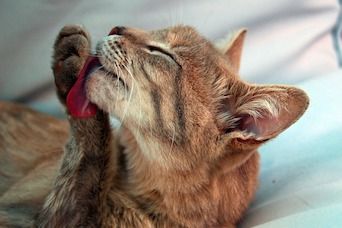Could Ulcerative Dermatitis in Cats Be Linked to Poor Welfare?
Feline idiopathic ulcerative dermatitis may be a behavioral disease associated with poor welfare, researchers say, prompting a name change to “feline behavioral ulcerative dermatitis.”

A healthy cat spends about 8% of its nonresting time grooming. Excessive grooming can indicate poor welfare. For example, self-induced alopecia, a psychogenic disorder in cats, is also known as “stress-related overgrooming.”
Feline idiopathic ulcerative dermatitis (IUD) is a rare grooming disorder of unknown etiology characterized by head and neck pruritus and self-induced erosive and ulcerative cutaneous lesions. It does not respond to medications but resolves spontaneously when self-mutilation is prevented. Unfortunately, feline IUD can decrease the quality of the human-cat relationship, to the point where the affected cat’s owner may elect euthanasia. What’s more, psychogenic pruritus in cats is frequently misdiagnosed as feline IUD, potentially leading to improper and expensive disease management.
RELATED:
- Feline Skin Syndromes: The Frustrating Feline Triad & More
- ACVC 2017: Understanding Skin Disease in Cats
To date, small animal—specific welfare assessments have not been developed. Given the link between environmental stress and abnormal feline grooming behavior, a research team investigated whether feline IUD is actually a behavioral disorder indicative of poor welfare. Their findings were recently published in Frontiers in Veterinary Science.
Assessment
Forty-eight pet cats (35 with IUD, 13 healthy) were recruited. The cats with IUD received a behavioral assessment to evaluate their welfare.
All cat owners completed a welfare assessment that comprised elements of other animal welfare assessments (ie, Welfare Quality, Animal Welfare Indicators). The assessment evaluated how much control cats had over their resources and environment (eg, Does your cat have hiding places?). Cats received a welfare score from 0 (no welfare problem) to 21 (serious welfare problem). The assessment was completed at study inclusion and at a recheck appointment.
Owners of cats with IUD were instructed to implement environmental modifications, including providing permanent food access and regularly offering new toys.
Results
Most study cats lived strictly indoors. For cats with IUD, the median age of disease onset was 19 months and clinical signs were predominantly excoriations. Most skin lesions were in the cervical area; others were located on the head and shoulders.
At the beginning of the study, welfare scores were significantly higher for cats with IUD (16/21) than for healthy cats (7/21), indicating poor welfare in the affected cats. For 12 of 13 cats with IUD, skin lesions resolved and welfare scores dropped significantly with positive environmental modifications. “As soon as environmental changes were set up, pruritus stopped within 2 days…skin lesions healed quickly thereafter,” the investigators observed. The lesions did not recur after up to 24 months. Notably, free outdoor access markedly improved skin healing.
The remaining cat with IUD did not improve. This cat’s owners did not implement environmental modifications and instead elected for medical therapy with fluoxetine, which was ultimately unsuccessful.
At the recheck appointment, following environmental modifications, welfare scores were similar between the study groups.
Study Implications
The investigators cautioned against categorizing all cases of idiopathic head and neck pruritus as behavioral, given the study’s small sample size. However, it is reasonable to hypothesize that most cases indicate poor welfare and a subsequent abnormal behavioral response.
Thus, the investigators proposed changing the name of feline IUD to “feline behavioral ulcerative dermatitis,” provided that the following items are present: (1) self-induced grooming lesions, (2) poor welfare score associated with repetitive grooming behavior, and (3) complete healing that follows individualized environmental modifications.
Future, larger studies will be needed to further explore the link between feline ulcerative dermatitis and environmental stress. In addition, “the welfare scoring could be a useful tool to investigate other repetitive behaviors,” the investigators concluded.
Dr. Pendergrass received her DVM degree from the Virginia-Maryland College of Veterinary Medicine. Following veterinary school, she completed a postdoctoral fellowship at Emory University’s Yerkes National Primate Research Center. Dr. Pendergrass is the founder and owner of JPen Communications, a medical communications company.